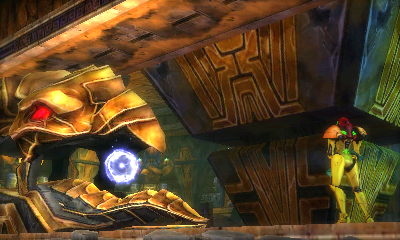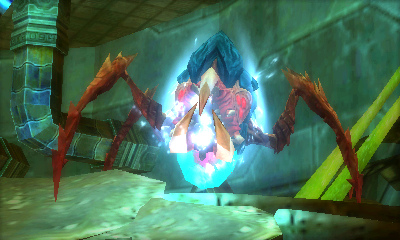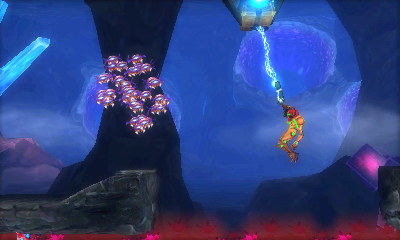The Metroid franchise has been in a strange place for some time now. Not since 2010 have we received a game where Samus starred as the main protagonist. Although Metroid Prime: Federation Force released in 2016, Samus was relegated to the role of side character. Fans of the series wanted more, and to our great delight, we were treated to a surprise announcement a year later. With a move that no one could have seen coming, Nintendo revealed not one, but two Metroid games during 2017’s E3 conference. Crazier still was that one of the games would be out before the end of the year. That game is Metroid: Samus Returns, a remake of Metroid II for the Game Boy. Aptly named, it serves as Samus’ return from dormancy. But does it also mark a return to form for the franchise? It undoubtedly does.
For the uninitiated, the story of both Samus Returns and Metroid II revolve around Samus and her mission on the planet SR388. Due to the inherent threat that Metroids possess both on their own and from being manipulated by outside sources like Space Pirates, the Galactic Federation tasks Samus with landing on the Metroid’s home planet and eradicating them completely. Samus’ journey has her delve further and further under the surface of SR388, with her progress being hindered until all Metroids in the surrounding area have been slain. Luckily, Chozo statues in each locale will display how many Metroids are present to give you an idea of what to expect. Thorough players will be rewarded with access to Chozo Memories, extra tidbits of lore that provide some backstory for the Metroids and Chozo.
Those familiar with the original game can attest that, despite it being competent for its time, it has not aged gracefully. Samus Returns takes nearly all of the original’s shortcomings and drastically improves upon them. Plentiful Save Stations, teleporters, and a cohesive map make playing the game a much more pleasant affair. The lack of a map and copious amount of backtracking were some of the biggest criticisms of the original, but Samus Returns has addressed that issue beautifully. Areas of SR388 are much easier to navigate, with shortcuts and teleporters making traversal much more manageable and less of a headache. The touch screen also has a map of the current section open at all times and even includes the ability to mark certain areas with pins. Is there an upgrade you can’t reach because you don’t yet possess the requisite ability? If so, merely place a pin on the map and you can come back to obtain the item later. These quality of life updates make for a conducive experience.
The attention to detail doesn’t stop there. One of the most impressive aspects of Samus Returns is how the plethora of little nuances add to the game as a whole. The original Metroid II didn’t have much power to work with on the Game Boy, but MercurySteam has taken full advantage of the 3DS and what it is capable of rendering. The environments in Samus Returns are recognizable from the original, but have been greatly reinvigorated. They’re teeming with things like indigenous wildlife or machinery humming in the background, with each section of SR388 feeling inherently distinct from the rest. The result is something that, while faithful to the original, even down to each section’s layout, carves its own identity and feels incredibly fresh and new.
In addition to the enhanced gameplay, Samus Returns seems to take much of what the Metroid series has to offer and has packed it all together. The music is a mix of original songs, blended with fan favorites spanning the entire Metroid series. Each area of SR388 has a distinctive theme, contributing significantly to its ambiance. Cutscenes and cinematics are minimalistic, yet convey a gripping narrative without a word being uttered a la Super Metroid and Metroid Prime. It has that old-school, 2D feel, while modernizing it with updated features to appeal to both seasoned and new fans alike. Samus Returns seems to want to illustrate what made the franchise so great in the first place, and it does so marvelously.
The Metroids that Samus encounters serve as the brunt of the game’s bosses and are suitably intense. Metroids have many stages of evolution, with each progressive form becoming more dangerous than the last. The methods of defeating Metroids at the same evolutionary point may be identical, but the environmental hazards and rules of engagement help keep the fights from getting too stale. For instance, although you’ll battle a fair amount of Alpha and Gamma Metroids, they frequently attempt to use the surrounding terrain to their advantage. The weapons at Samus’ disposal grow in power as the game progresses, but so do those of the Metroids. The latter fights with them become quite nerve-wracking, especially with the Metroids taking on more primal and savage appearances. As I grew closer to the end of the game, the radar on my minimap alerting me that a Metroid was near served as an ominous reminder that a deadly foe soon awaited me.
Besides her standard repertoire, MercurySteam has given Samus some tools that weren’t present in her original adventure on SR388. A particularly impactful technique is that of the Melee Counter. By pressing X at the right time as an enemy is charging you, Samus will effectively parry the incoming attack, stun the enemy in question, and deal massive retaliatory damage if you opt to fire. Enemies susceptible to the Melee Counter will flash briefly to warn you of an impending assault. Successful counters on bosses and hardier enemies will often lead into cinematic sequences with Samus performing acrobatic maneuvers akin to those found in Other M. While not necessary to your success on SR388, effectively using the Melee Counter will make your life much easier. The window to pull off a Melee Counter isn’t terribly strict, but it isn’t generous either, making it gratifying and a joy to use.
Another new inclusion for Samus in Samus Returns are Aeion abilities. Aeion abilities bestow unique, powerful effects on either Samus or her surrounding environment. For example, one of the powers you obtain sends a pulse throughout the immediate area, revealing breakable walls and terrain, in addition to charting nearby items and upgrades on your minimap. Another power encases Samus with lightning that doubles as a shield against oncoming damage and powers up her Melee Counter. Because of how substantial these abilities are, using them requires Aeion energy. Your current level of Aeion energy can be observed from the Aeion Gauge, which can be replenished by successfully Melee Countering enemies, slaying them outright, or by finding stations that refill the gauge for you. The Aeion Abilities are an interesting addition to Samus Returns and successfully utilizing them can easily turn the tide of battle in your favor against the more threatening enemies you’ll encounter. You can even use them in tandem with one another, leading to some explosive surges in firepower for Samus.
But perhaps one of the most important facets of the game is Samus herself and how it feels to don the Power Suit again. Thankfully, she controls like a dream. Her ground movement and jumps are quick and make her feel incredibly nimble. Learning the lay of the land and being able to deftly scale ledges and cliffs is immensely satisfying. In terms of weaponry, her arsenal is as varied as it is powerful. Fans of the series will recognize many of the upgrades Samus will receive on her adventure and the controls don’t disappoint on that front either. Switching between beams, Aeion Abilities, and missiles with the touch screen of the 3DS is seamless and will likely resonate with those who enjoyed the Metroid Prime games. Samus having the ability to aim her arm cannon in any direction while holding down the L button is another noteworthy boon. Aiming via this method even produces a laser so that you know exactly where Samus is going to fire. While a seemingly small change, it makes a world of difference and I hope it’s an addition that all future 2D Metroid games incorporate.
However, Samus Returns isn’t faultless. With each section of SR388 being vastly different from the rest, one would expect the endemic enemies to be varied and unique as well. Much to my dismay, I frequently encountered the same enemies in many of these areas with identical attack patterns, meaning I already knew how to effectively combat them. This is further exacerbated by my adversaries merely being differently colored and given more health. It’s a curious decision of the developers, given the variety present in the rest of the game. This phenomenon bleeds into the skirmishes with the Metroids, too. The fights are enjoyable, but the sheer amount of them make the bouts somewhat methodical.
Metroid: Samus Returns also supports the various Metroid amiibo that have been released, should you happen to own them. While completely optional, they can be used to help make your life a little easier. The Smash Bros. amiibo grant you an extra missile expansion or energy tank, as well as additional features once you’ve completed the game. Much to my surprise, the enemies you’ll face can be quite lethal, so there’s certainly no shame in choosing to use the amiibo to give you that extra edge. Hard Mode amplifies the damage you take further, making even seemingly small mistakes potentially fatal.

In the end, what makes Metroid: Samus Returns so special is that it’s far more than the sum of its parts. It isn’t just a remake, it’s a love letter to fans of the series and a window to Metroid’s past, as well as its future. It’s the culmination of every game that has come before it while simultaneously serving as an emissary of the potential that the series holds. By no means is it a perfect game, nor is it the best in the franchise, but it is a promising start to Metroid’s resurgence. Samus has indeed returned, and it is a glorious one at that.
Review copy provided by Nintendo of America



